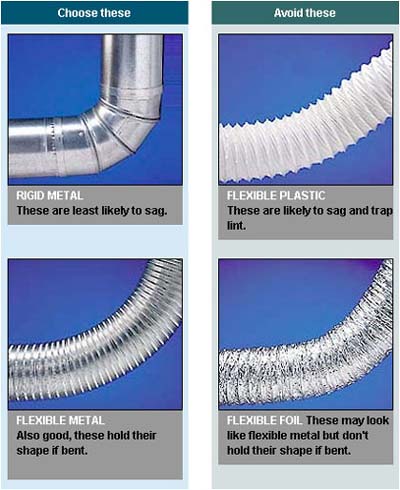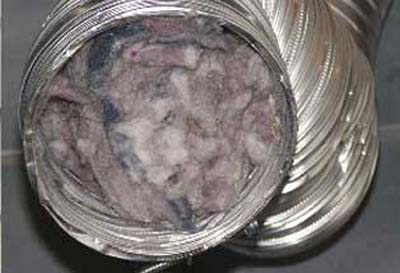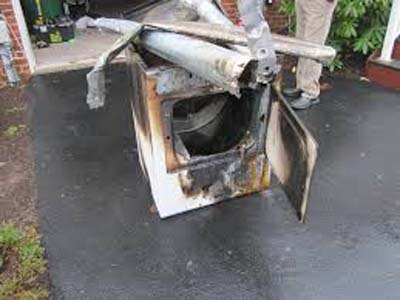LINT CLOGGED DRYER VENT
Lint Clogged Dryer Vent
- Lint Clogged Dryer Vent
- Although most people are not aware of this, lint buildup in your clothing dryer vent is more likely to cause a house fire than your chimney! Particularly risky are the dryer vents of electric dryers. The U.S. Consumer Product Safety Commission (USCPC) wrote a report called the “Report on Electric and Gas Clothes Dryers” where they determined that of the “15,000 fires studied in one year, electric dryers were over 2.5 times more likely to be the cause of the fire than gas dryers”. Furthermore, most of these house fires originated in the dryer vent and the lint trap. Regardless of the type of dryer you have, a clogged vent or lint trap occurs from a buildup of lint. Lint is highly flammable and a serious fire hazard if you do not regularly clean your dryer vent. Removing the lint from the lint trap after each time you use it is not enough to prevent a house fire.
- Why is Dryer Lint Highly Flammable?
- Dryer lint is a combination of bundled clothing fabrics such as cotton, wool, and linen that come off your clothes when they are tumbling around in your dryer. These particles are highly flammable and make perfect kindling. If you ever need to start a fire, dryer lint is actually great tinder. Not only are the materials of lint highly flammable, but when lint buildup in your exhaust system blocks air flow from your dryer, it causes the temperature of the dryer to remain hotter. The combination of a flammable clump of lint in a hot dryer vent with restricted airflow will eventually catch fire.
- Improperly Installed Dryer Vent Hose & Unsafe Dryer Hose Materials
- First
of all, when choosing where to
install your dryer, never allow the
dryer vent exhaust to terminate
under your house or inside an attic
space. New
construction trends are placing
laundry rooms in untraditional parts
of the house. These
locations require longer dryer duct
runs and more elbow fittings in
order to reach an outside wall.
The longer and more turns the
vent has, the harder it is to keep
clean from lint buildup.
Any additional bends and
elbows create nooks for lint to
accumulate and reduce the dryer’s
ability to efficiently vent air.
Please be aware that flexible
aluminum pipes or plastic pipes are
not fire safety code compliant and
should never be used to vent your
dryer. Aluminum
and plastic materials deteriorate
quickly and are more easily crushed
during installation, which reduces
the venting capacity. If
you have this kind of dryer vent, it
should be replaced with a metal vent
immediately.

-

- Warning Signs of a Potential Dryer Fire
-
1.
Your dryer is
becoming slower to dry your clothes
2. Your clothes are not fully dry after a full drying cycle
3. Your clothes are hotter than normal at the end of the drying cycle
4. The outside of the dryer gets very hot during and after it is run
5. The outside exhaust vent flapper does not open very much indicating low exhaust velocity
- House Fires caused by Clothing Dryers
- Often, dryers are left unattended when they are on and in use which is why these fires get out of hand before they can be extinguished. The dryer vent is hidden behind the dryer and by the time the fire is caught, it can create a lot of damage in the meantime. The U.S. Fire Administration, National Fire Data Center reports that “there are over 12,700 home fires per year associated with clothes dryer fires resulting in 15 deaths and 300 injuries, and 88 million dollars in property loss.”
- Dryer Exhaust System Recommendations
- Our recommendation is to regularly check and clean the inside of your dryer exhaust system vents. Also ready your owner’s manual for the specifics to your machine and make sure you understand how to service it. Because all households use their dryer at varying frequencies, we recommend continually monitoring the airflow in your vents to ensure they are clear throughout the year. There is no standard amount of cleaning to recommend, however, you should definitely clean your lint tray before every use of your dryer. Also, monitor the trap door at the end of exhaust vents and make sure they are not clogged by lint or a nest or other debris that could gather. Not only will these steps reduce your risk of a house fire, they will also increase the lifespan of your dryer because it will require less energy and run more efficiently if it is not clogged.
If the idea of taking apart your dryer vents or getting on the roof to inspect the end of your dryer exhaust do not appeal to you, or you feel you lack the expertise, don’t worry. Most certified chimney sweeps on our site will also perform an inspection and cleaning of your dryer exhaust system when they come to look at your chimney. In fact, many have the CSIA Certified Dryer Exhaust Technician Credential.
Call one of our chimney sweep companies today to come out and inspect your dryer and chimney. Having your dryer vent professionally inspected and cleaned helps reduce the possibility of a fire, reduces energy consumption, reduces operating costs, and increases the lifespan of your dryer.
